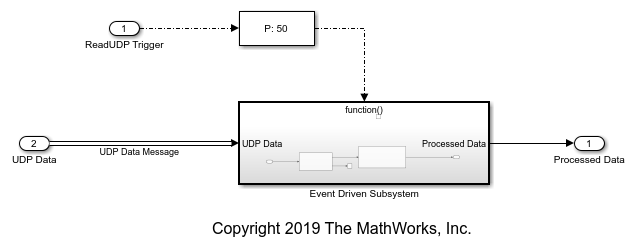Event-Driven Task
This example shows how to use the task manager block to a simple system where data from UDP source gets processed asynchronously each time a data packet arrives.
Task Manager and Software Application Model
The following model simulates a software application running on an ARM processor. A Task Manager block schedules the execution of the Asynchronous Subsystem, inside the Software Application Model block. An IO Data Source block simulates the network transmission of UDP packets.

The Software Application contains the Asynchronous Task Subsystem, a Function-Call Subsystem, that executes each time an event trigger occurs. An Asynchronous Task Specification block specifies the priority of the UDP Task to match the priority set in the Task Manager block. A Rate Adaptor block allows sampling of the output signal of the Asynchronous Task Subsystem at the time step of the Simulink(c) model.

The Asynchronous Task Subsystem, a Function-Call Subsystem, reads a data value from a UDP Read block and applies the Algorithm each time a new UDP data value arrives. In this model, the algorithm outputs the negative scalar value received from the UDP Read block. The following model shows the UDP block and Algorithm subsystem contained in the function-call subsystem.

Asynchronous Simulation and Results
Click the Run button to build and run the model. When the model finishes running, open the Simulation Data Inspector to see the results of the simulation. Select the ReadUDP, original data, and processed data signals to see the effect of asynchronous task execution.

As shown in the Simulation Data Inspector, the Running time of the ReadUDP varies at each instance of receiving a UDP data packet. In some cases, the previous task execution delays the start of the next task execution. While, in this example, the UDP packets arrive at a fixed rate relative to the Simulink sample time, the start of the task execution is not directly dependent on the sample time. The processed data from the task outputs at a the completion of the task execution, resulting in observed delay in the processed Data compared to the original data.